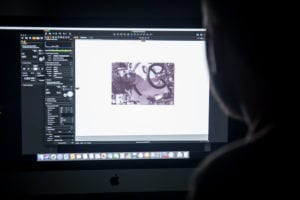Preserving Automotive History One Frame at a Time

As the world becomes increasingly reliant on digital technology, so too does the preservation of historical artifacts. Institutions across the world are working to create digital surrogates of original materials in order to preserve as much information as possible for future generations. Here at Revs Institute, we have been rapidly digitizing our own photographic collections since 2012, at a rate of 6,000 images per month. These images include all types of conventional photography, from 35mm film to fragile, but extremely detailed, glass-plate negatives.
More recently, Revs Institute made the decision to bring digitization in-house using state-of-the-art equipment and following library best practices, giving us full control over the process from when a collection first arrives in Naples, Florida, to when it’s finally uploaded to Revs Digital Library (RDL).

Revs has amassed a large collection of photographic film and prints ranging from the early 1900s to the 21st century. This 100-year span of material includes film types of all sorts, from the familiar 35mm slides to dangerous nitrate films from the first half of the century, which if improperly stored can spontaneously combust — not ideal for long-term storage. While these film types are all very different, they have one thing in common: They degrade over time.
It may seem obvious, but film degradation is inevitable, and once a photograph has deteriorated, there’s no way to bring it back. That’s where digitization comes in. By creating a digital facsimile of the original photo, we can preserve the content within the image and, along with proper file storage and regular backups, can ensure it is preserved far into the future.

So how do we do it? Well, the simple truth is that we take a photo of the original photo, albeit with a very powerful digital camera. The Phase One iXG camera used for in-house digitization features a 100-megapixel sensor, which translates to an image file with over 100 million pixels in it (100 megapixels.) For reference, a standard professional camera typically has anywhere from 20 to 40 megapixels. This capability is what allows us to scan such a variety of film types while still meeting or exceeding federal standards for resolution, dynamic range, noise, bit depth, and other parameters.
Along with the high-tech hardware, we also use the latest software by Capture One. In addition to the usual suite of photography tools, this software contains features like auto-crop, the ability to make micro adjustments to the focus of the camera, and built-in color profiles designed specifically for the Phase One iXG camera system.

After the original film is individually digitized, we follow archival best practices and safely relocate the material to our temperature and humidity controlled archive for permanent storage. The digital copies undergo final quality control checks, are safely backed up, and uploaded to the RDL. As of publication, the RDL houses over 530,000 images. These images cover a wide range of automotive history, from major racing events to international auto shows. Regular users include researchers, restoration experts, and enthusiasts.
The Revs Digital Library also allows us to more effectively find and use the photographs for our own restoration projects. Photos are often used as a reference when restoring a car, especially racing cars or small-production-run vehicles. They can be a crucial resource for restorers because no two race cars are exactly alike, and teams often developed and modified cars over the course of their racing careers or even during a single race weekend.

In the case of our Porsche 908/02 “Flunder,” which was restored by the expert hands at Gunnar Racing in 2016, we used newly discovered period photos from the 1969 Nürburgring 1,000 km race to make some cosmetic tweaks. These changes more closely match the car to its exact configuration at the Nürburgring in 1969, where the car made its competition debut. We even went as far as to photograph the car at the exact same angle as the period photos in order to compare the two and make changes as needed. During the process, we found several images of the car in the RDL, which we used for reference on each aspect of the car that was changed, from body lines to sticker placement.

At Revs, we are dedicated to deepening our collective understanding of automotive history, which is why we are engaged not only in the display and preservation of the world’s great automobiles, but also in assembling a library that documents those cars and their impact on society.
However, unlike our cars on display, which can be restored and re-restored, film from the 20th century has a finite lifespan. Potentially vital information could be permanently lost after it deteriorates, which is why we are committed to digitizing our film collections and sharing them with the automotive community with the Revs Digital Library. We hope you get a chance to use the library, whether you take a casual look or are undertaking a significant restoration project.
If you would like to learn more about Revs Digital Library or browse our images, then follow this link: https://library.revsinstitute.org/digital/
Simply use the keyword search box to find exactly what you are looking for and narrow your search with the facets on the left side of the page. If your interested in purchasing an image for commercial or non-commercial use, then you can utilize the “buy button” on the individual image page.